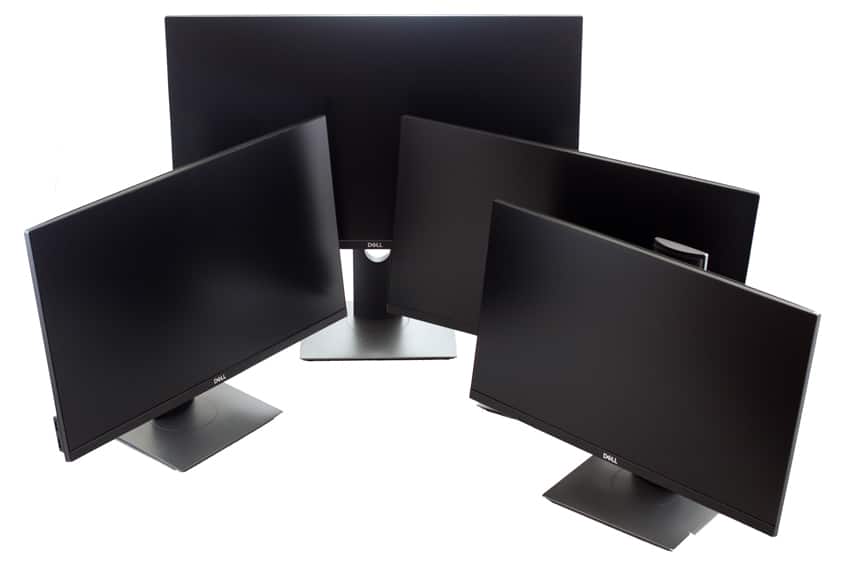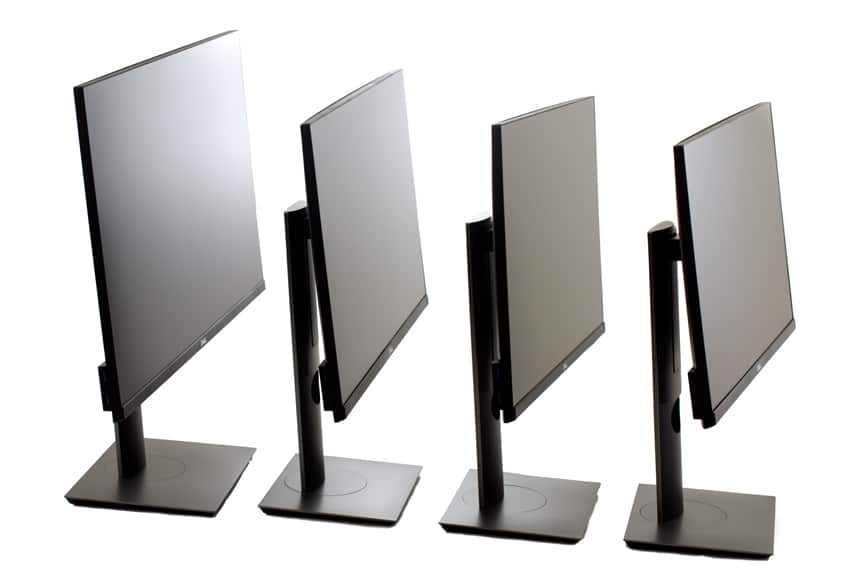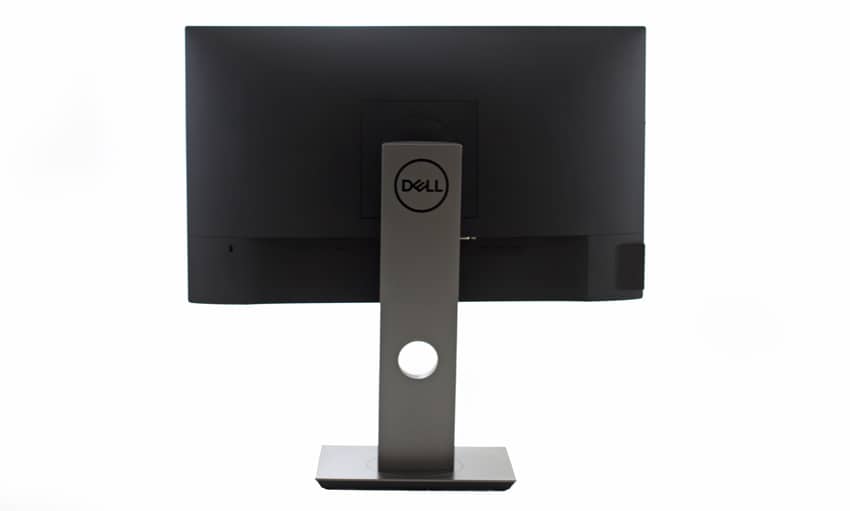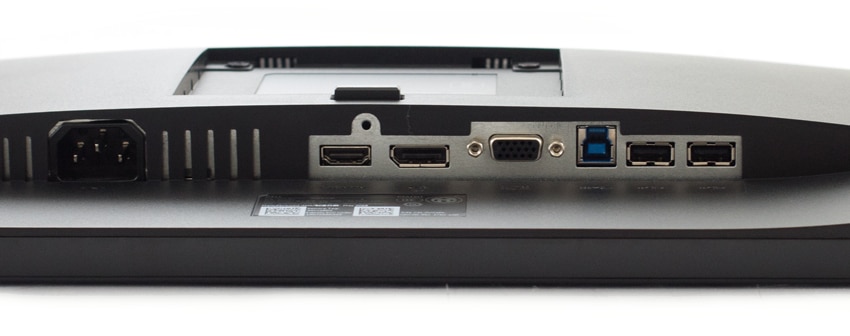Dell has recently updated their mid-range lineup of monitors: P2219H (21.5-inch), P2319H (23.0-inch), P2419H (23.8-inch) and P2719H (27.0-inch). We will be looking at these new Dell displays in one sweeping review as there’s virtually no difference between each model from this updated line, except for the display size, which is indicated in the first two numbers of their product name.

Normally, we spend our time looking at larger monitors that help people do more with their on-screen real-estate; however, not everyone has an opportunity to get a huge, expensive display. This makes them a very attractive, inexpensive alternative to the pricey 2K, 4K and 5K monitors (if you’re not working as a media, design or video professional), which can cost over few thousand dollars. The market for 1080p monitors is also still very strong because the resolution and feature-set is simply sufficient for most people.
The Dell P monitors are fairly versatile with their tilt, swivel, height, and rotate adjustment capabilities, and support for a range of mounts and stands. These monitors also feature a wide viewing angle via In-Plane Switching technology. This allows users to experience the same vibrant colors no matter which angle they are looking from.
Dell’s refreshed mid-range monitors also feature good power efficiency. If you install VESA’s DPM compliance software or use the display card, the monitors will automatically reduce their power consumption when not in use via its “Power Save Mode.” When the host computer detects an input from the keyboard, mouse or another device, the monitor automatically resumes to function.
Dell P2219H and P2319H Specifications
| Models | P2219H | P2319H | ||
| Panel technology | In-Plane Switching Technology | |||
| Aspect ratio | 16:9 | |||
| Viewable image | ||||
| Diagonal Width (active area) Height (active area) Total area |
546.10 mm (21.5 inches) 476.06 mm (18.74 inches) 267.79 mm (10.54 inches) 127484.10 mm2 (197.60 inch2) |
584.20 mm (23.0 inches) 509.18 mm (20.05 inches) 286.42 mm (11.28 inches) 145839.33 mm2 (226.05 inch2) |
||
| Pixel pitch | 0.248 mm x 0.248 mm | 0.265 mm x 0.265 mm | ||
| Pixel per inch (PPI) | 102 | 96 | ||
| Viewing angle | 178° (vertical) typical 178° (horizontal) typical |
|||
| Luminance output | 250 cd/m² (typical) | |||
| Contrast ratio | 1000 to 1 (typical) | |||
| Faceplate coating | Anti-Glare with 3H hardness | |||
| Backlight | LED edgelight system | |||
| Response time | 8 ms (Normal) 5 ms (Fast) |
|||
| Color depth | 16.7 million colors | |||
| Built-in devices | •USB 3.0 super-speed hub (with 1 x USB 3.0 upstream port) •2 x USB 3.0 downstream ports •2 x USB 2.0 downstream ports |
|||
| Ports and connectors | •1 x DisplayPort version 1.2 •1 x HDMI port version 1.4 •1 x VGA port •1 x USB 3.0 upstream port (bottom) •2 x USB 3.0 downstream ports (side) •2 x USB 2.0 downstream ports (bottom) |
|||
| Border width (edge of monitor to active area) | 5.62 mm (Top/Left/Right) 19.99 mm (Bottom) |
5.40 mm (Top/Left/Right) 19.86 mm (Bottom) |
||
| Adjustability | ||||
| Height adjustable stand Tilt Swivel Pivot |
130 mm -5° to 21° -45° to 45° -90° to 90° |
|||
| Dell Display Manager compatibility | Yes | |||
| Security | Security lock slot (cable lock sold separately) | |||
Dell P2419H and P2719H Specifications
| Models | P2419H | P2719H | ||
| Panel technology | In-Plane Switching Technology | |||
| Aspect ratio | 16:9 | |||
| Viewable image | ||||
| Diagonal Width (active area) Height (active area) Total area |
604.52 mm (23.8 inches) 527.04 mm (20.75 inches) 296.46 mm (11.67 inches) 156246.27 mm (242.16 inch) |
685.99 mm (27.0 inches) 597.88 mm (23.54 inches) 336.31 mm (13.24 inches) 201073.02 mm (311.67 inch) |
||
| Pixel pitch | 0.275 mm x 0.275 mm | 0.311 mm x 0.311 mm | ||
| Pixel per inch (PPI) | 92 | 82 | ||
| Viewing angle | 178° (vertical) typical 178° (horizontal) typical |
|||
| Luminance output | 250 cd/m² (typical) | 300 cd/m² (typical) | ||
| Contrast ratio | 1000 to 1 (typical) | |||
| Faceplate coating | Anti-Glare with 3H hardness | |||
| Backlight | LED edgelight system | |||
| Response time | 8 ms (Normal) 5 ms (Fast) |
|||
| Color depth | 16.7 million colors | |||
| Built-in devices | •USB 3.0 super-speed hub (with 1 x USB 3.0 upstream port) •2 x USB 3.0 downstream ports •2 x USB 2.0 downstream ports |
|||
| Ports and connectors | •1 x DisplayPort version 1.2 •1 x HDMI port version 1.4 •1 x VGA port •1 x USB 3.0 upstream port (bottom) •2 x USB 3.0 downstream ports (side) •2 x USB 2.0 downstream ports (bottom) |
|||
| Border width (edge of monitor to active area) | 5.38 mm (Top/Left/Right) 20.31 mm (Bottom) |
6.00 mm (Top/Left/Right) 20.70 mm (Bottom) |
||
| Adjustability | ||||
| Height adjustable stand Tilt Swivel Pivot |
130 mm -5° to 21° -45° to 45° -90° to 90° |
|||
| Dell Display Manager compatibility | Yes | |||
| Security | Security lock slot (cable lock sold separately) | |||
Design and build
The Dell P monitors are identical in connectivity and design, so this next section applies to all models. As such, they sport a thin profile and monitor base with a reduction of 22% compared to its predecessors. Coupling this with its three-sided ultra-thin bezel design (top and side), creates a slick looking monitor for its class. Though sturdy, they are also very maneuverable

The line also features an improved cable management slot, which is located in the middle of the stand.

At the right base of the screen are four function buttons next to the power button, including the Shortcut Preset Modes button, which allows the user to choose from a list of preset color modes; the Input Source, which allows the users cycle through list of video signals connected to your monitor; the Menu button, which launches the On-Screen Display (OSD); and the Exit button, which exits the OSD main menu. These buttons are also used to navigate the OSD menus (Up, down, OK and back, respectively). We found the menus easy to use and to quickly navigate through. The modes are especially helpful when switching form normal use (writing, emails, inter-office messaging, web usage) to photo editing as one can have the settings change to a brighter white that translates into better photos.
Once the stand is attached to the Dell monitor, users can tilt (5 degrees forward, 21 degrees back) and swivel (45 degrees to either the left of right) the monitor to create a their own comfortable viewing angle. This was easy to do, and just required us to push or pull the monitor in the direction we wanted it to go. Users can also extend the monitor vertically up to 130 mm via the stand and rotate the monitor 90 degrees to either side for a portrait viewing experience for those who need it. Though mostly a standard feature among newer monitors, this is a great feature for those looking for a second monitor to display long lists of data or analytics to improve their efficiency at work.

Underneath the display shows the usual connectivity for mid-range monitors: a power connector, an HDMI port, stand lock feature, DisplayPort, one USB upstream port and two USB downstream ports, and VGA connector for older devices. The left side of monitor also features two more USB downstream ports. Getting to the ports under the monitor was simple and for the most part can be done without even flipping the monitor around.
Conclusion
The P2219H, P2319H, P2419H and P2719H are solid additions to Dell’s mid-tier portfolio of monitors. They feature the usual quality parts that Dell is known for, are easy to snap together out of the box, and all models are not overly heavy.
Though professional photo/video editors and hardcore gamers with larger budgets will likely go for larger screens with higher resolutions, this family still has a lot to offer. Moreover, their diverse range in screen real-estate (21.5-inch to 27-inch) allows the P line to suit a wide range of use cases. As such, they are perfect for applications like general usage and preparing presentations due to their bright and high-quality screens. Gamers on a budget who are satisfied with a 1080p experience will also find these monitors well suited to their needs (it offers a decent response time of 5ms, grey to grey, as well). For our purposes, we used them for writing content and editing photos. We found that switching modes and brightness for writing versus photo editing was quick and seamless, allowing for an overall effective workflow.
Going for roughly $192 for the 22-inch, $220 for the 23-inch, $230 for the 24-inch, and $300 for the 27-inch, these monitors are definitely worth picking up if you are looking for a mid-range monitor.




 Amazon
Amazon